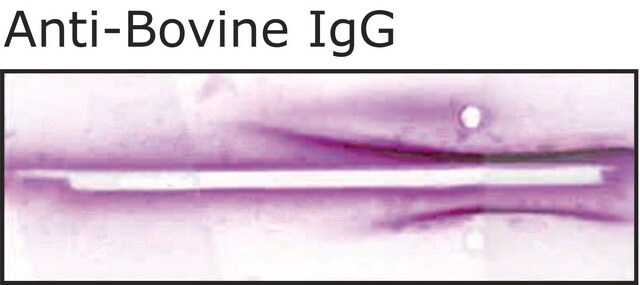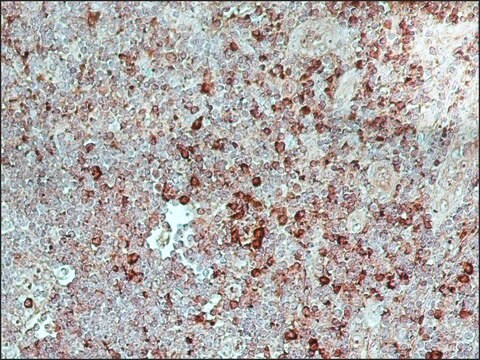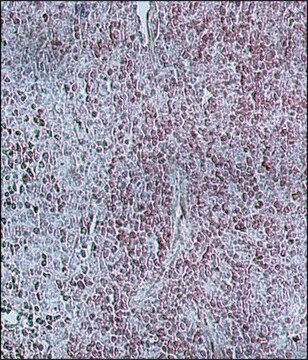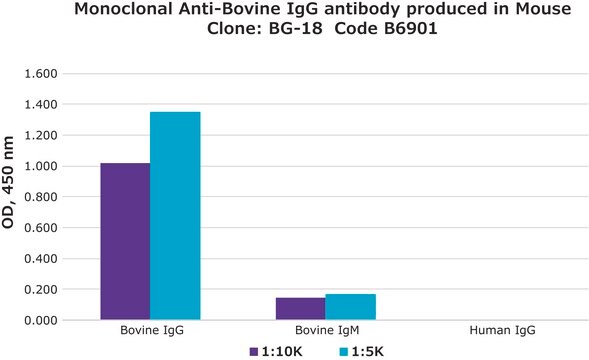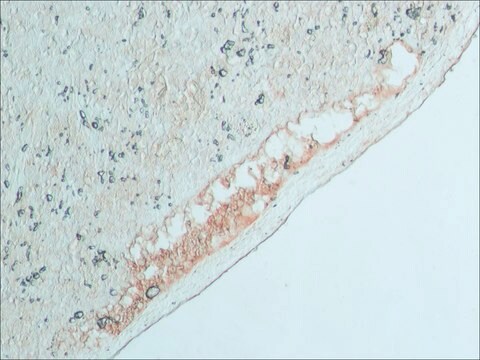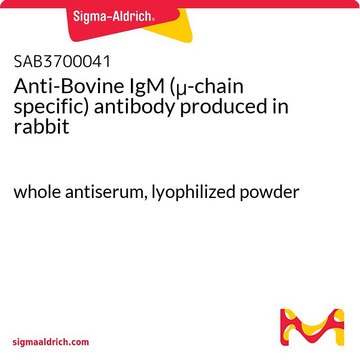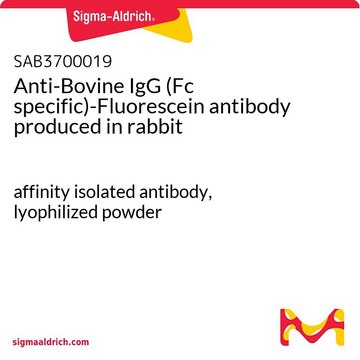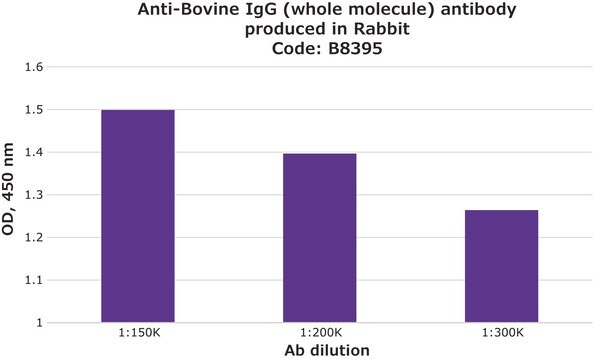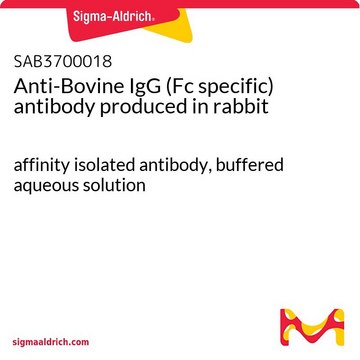SAB4200796
Anti- Bovine IgG-Peroxidase antibody, Mouse monoclonal
clone BG-18, purified from hybridoma cell culture
同義詞:
Bovine immunoglobulin G
登入查看組織和合約定價
全部照片(2)
About This Item
分類程式碼代碼:
12352203
NACRES:
NA.43
共軛:
peroxidase conjugate
application:
ELISA (d)
無性繁殖:
BG-18, monoclonal
物種活性:
bovine
citations:
1
技術:
direct ELISA: 1:20,000-1:40,000 using 1 μg/ml bovine IgG for coating
推薦產品
生物源
mouse
品質等級
共軛
peroxidase conjugate
抗體表格
purified from hybridoma cell culture
抗體產品種類
primary antibodies
無性繁殖
BG-18, monoclonal
形狀
lyophilized powder
物種活性
bovine
濃度
~2 mg/mL
技術
direct ELISA: 1:20,000-1:40,000 using 1 μg/ml bovine IgG for coating
同型
IgG1
運輸包裝
dry ice
儲存溫度
−20°C
目標翻譯後修改
unmodified
一般說明
Monoclonal Anti-Bovine IgG (mouse IgG1 isotype) is derived from the BG-18 hybridoma, produced by the fusion of mouse myeloma cells and splenocytes from a mouse immunized with the purified bovine IgG.
Immunoglobulin G (IgG) contributes to 10–20% of plasma protein and is regarded as one of the most predominant serum protein. It consists of four subclasses: IgG1, IgG2, IgG3 and IgG4. The IgG structure possesses four polypeptide chains containing two identical γ heavy (H) chains and two identical κ or λ light (L) chains of 50 kDa and 25 kDa, respectively.
Immunoglobulin G (IgG) contributes to 10–20% of plasma protein and is regarded as one of the most predominant serum protein. It consists of four subclasses: IgG1, IgG2, IgG3 and IgG4. The IgG structure possesses four polypeptide chains containing two identical γ heavy (H) chains and two identical κ or λ light (L) chains of 50 kDa and 25 kDa, respectively.
The bovine immunoglobulin system closely resembles that of other mammalian species with respect to the physiochemical properties and nomenclature. The main bovine IgG class antibodies are IgG1 and IgG2, which have antigenic differences in the Fc region of the heavy chains.4
特異性
Monoclonal Anti-Bovine IgG specifically recognizes an epitope on the heavy chain of both bovine IgG1 and IgG2. The antibody shows no cross-reactivity with bovine IgM or IgG from the following species: human, goat, sheep, rabbit, pig, dog, chicken, cat, guinea pig or horse.
免疫原
Purified bovine IgG
應用
The antibody is recommended to use in various immunological techniques, including ELISA1, Immunohistochemistry2 and Immunobloting3
生化/生理作用
Different immunoglobulin classes and subclasses (isotypes) perform distinctive effector functions. Therefore, the ability to characterize antibody isotype is fundamental to the analysis of the immune response. The diversity of immunoglobulin isotypes associated with the immunity pattern serves as an indicator indistinguishing the phase of infection with various agents.
外觀
Supplied as a lyophilized powder.
儲存和穩定性
Store the lyophilized product at 2–8 °C. For extended storage after reconstitution, keep at –20 °C in working aliquots. Avoid repeated freeze-thaw cycles. For continuous use after reconstitution, keep at 2–8 °C for up to 1 month. Solutions at working dilution should be discarded if not used within 12 hours.
免責聲明
Unless otherwise stated in our catalog our products are intended for research use only and are not to be used for any other purpose, which includes but is not limited to, unauthorized commercial uses, in vitro diagnostic uses, ex vivo or in vivo therapeutic uses or any type of consumption or application to humans or animals.
未找到適合的產品?
試用我們的產品選擇工具.
訊號詞
Warning
危險聲明
危險分類
Skin Sens. 1
儲存類別代碼
12 - Non Combustible Liquids
水污染物質分類(WGK)
WGK 2
閃點(°F)
Not applicable
閃點(°C)
Not applicable
S S Saini et al.
Scandinavian journal of immunology, 65(1), 32-38 (2007-01-11)
Analysis of the heavy-chain gene (pTGHC9907) encoding a bovine IgG1 antibody against bovine herpes virus type 1 (BHV-1) isolated from a Holstein cow has led to the identification of a new IgG1 sequence allele. A comparison of nucleotide sequence of
Use of sandwich IgG ELISA for the detection and quantification of adulteration of milk and soft cheese
Ian P.Hurley
International dairy journal, 16, 805-812 (2006)
Histological and Immunohistochemical Studies on the Furstenberg's Rosette in Cows.
Asti RN
Kafkas U?niversitesi veteriner faku?ltesi dergisi, 17, 223-228 (2011)
A C Rodrigues da Silva et al.
Revista do Instituto de Medicina Tropical de Sao Paulo, 42(2), 95-98 (2000-05-16)
Despite the absence of current official reports showing the number of cattle infected by rabies, it is estimated that nearly 30,000 bovines are lost each year in Brazil. In order to minimize the important economic losses, control of the disease
Cheryl Jenkins et al.
Parasites & vectors, 9, 106-106 (2016-02-26)
Bovine theileriosis caused by Theileria orientalis is an emerging disease of cattle in the Asia-Pacific region where it causes a significant economic burden to meat and milk production. While host immunological responses to the lymphocyte-transforming species of Theileria, T. parva
我們的科學家團隊在所有研究領域都有豐富的經驗,包括生命科學、材料科學、化學合成、色譜、分析等.
聯絡技術服務